Search Result
Results for "
antipsychotic activity
" in MedChemExpress (MCE) Product Catalog:
7
Isotope-Labeled Compounds
| Cat. No. |
Product Name |
Target |
Research Areas |
Chemical Structure |
-
- HY-107969
-
|
|
Others
|
Neurological Disease
|
|
Haloperidol decanoate shows antipsychotic activity. Haloperidol decanoate can be used in schizophrenia and schizoaffective disorder research .
|
-
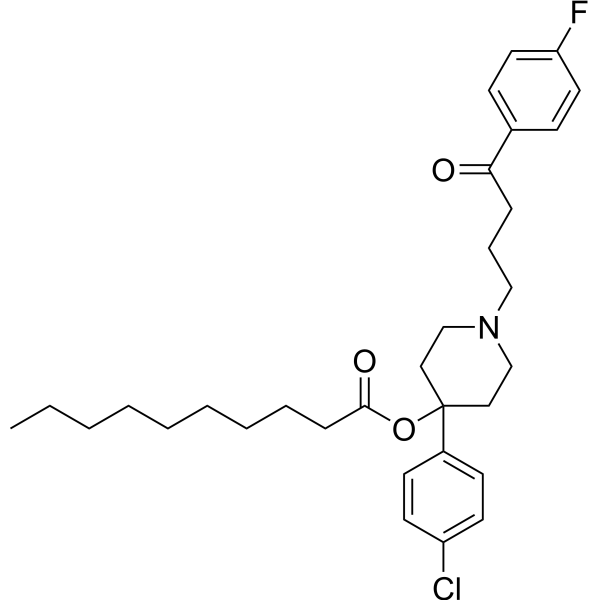
-
- HY-14543
-
-

-
- HY-W009247
-
|
N-Demethylolanzapine; LY170055
|
Others
|
Neurological Disease
|
|
N-Desmethylolanzapine is an antipsychotic drug.
The formation of N-Desmethylolanzapine correlates with the level and activity
of human liver flavin-containing monooxygenase (FMO3). N-Desmethylolanzapine
can be used in the study of antipsychotic drugs .
|
-
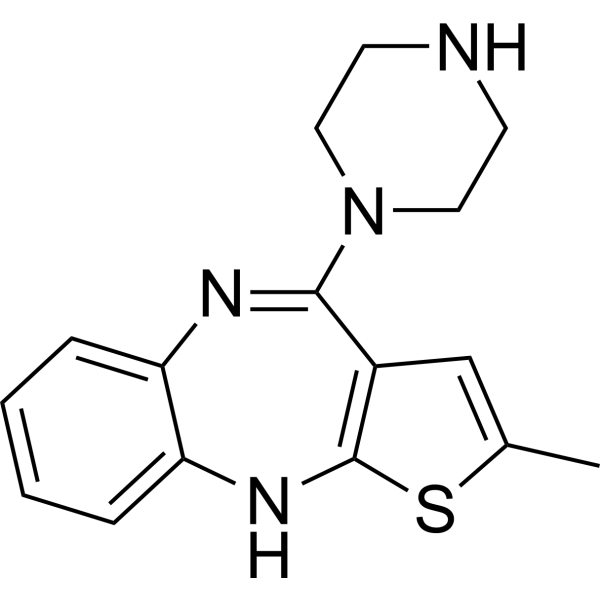
-
- HY-106584
-
|
Clospipramine
|
Dopamine Receptor
|
Neurological Disease
|
|
Mosapramine (Clospipramine) is an orally active and potent dopamine receptor antagonist with high affinity to dopamine receptor subtypes 2, 3 and 4, and with moderate affinity for the 5-HT 2 receptor. Mosapramine shows antipsychotic activity and can be used in schizophrenia research .
|
-

-
- HY-116855
-
|
|
mGluR
|
Neurological Disease
|
|
TASP0433864 is a selective positive allosteric modulator (PAM) of metabotropic glutamate 2 (mGlu2) receptor with EC50 values of 199 nM and 206 nM against human and rat mGlu2 receptors, respectively. TASP0433864 has antipsychotic activity .
|
-
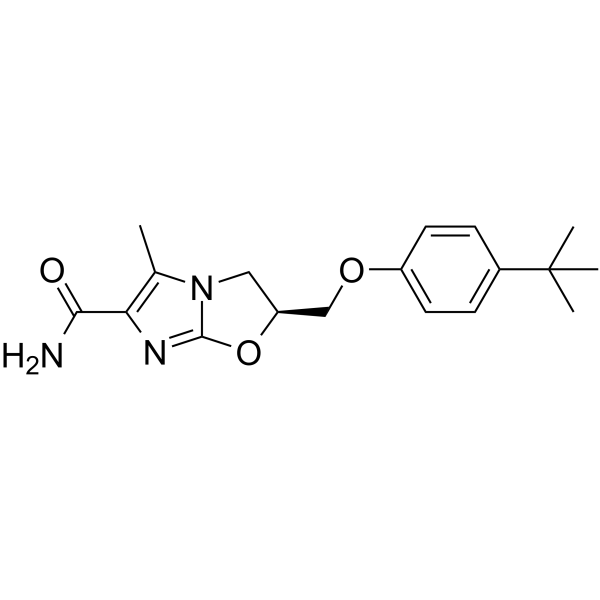
-
- HY-100665
-
|
OPC-14857; DM-14857
|
5-HT Receptor
|
Neurological Disease
|
|
Dehydroaripiprazole (OPC-14857) is an active metabolite of Aripiprazole. Aripiprazole is an antipsychotic agent and is metabolized by CYP3A4 and CYP2D6 forming mainly Dehydroaripiprazole. Dehydroaripiprazole has with antipsychotic activity equivalent to Aripiprazole .
|
-
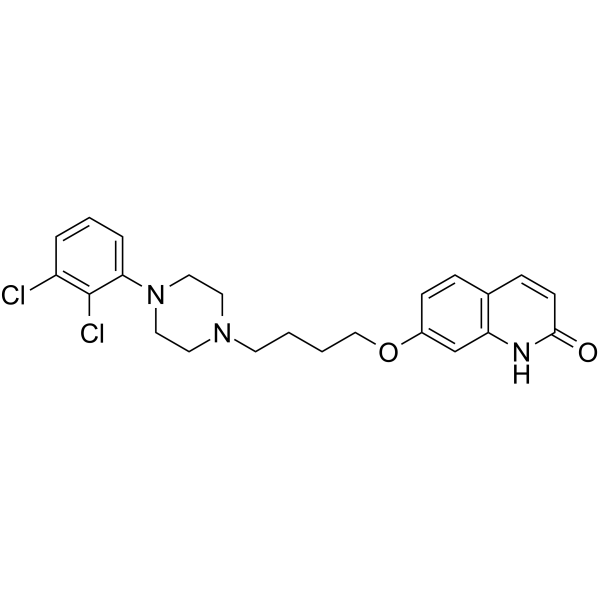
-
- HY-113575
-
|
OPC-14857 hydrochloride; DM-14857 hydrochloride
|
5-HT Receptor
|
Neurological Disease
|
|
Dehydroaripiprazole (OPC-14857) hydrochloride is an active metabolite of Aripiprazole. Aripiprazole is an antipsychotic agent and is metabolized by CYP3A4 and CYP2D6 forming mainly Dehydroaripiprazole hydrochloride. Dehydroaripiprazole hydrochloride has with antipsychotic activity equivalent to Aripiprazole .
|
-
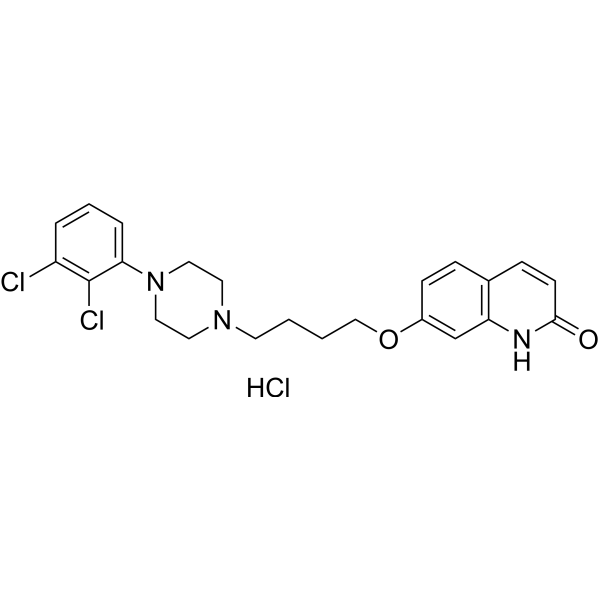
-
- HY-155378
-
-
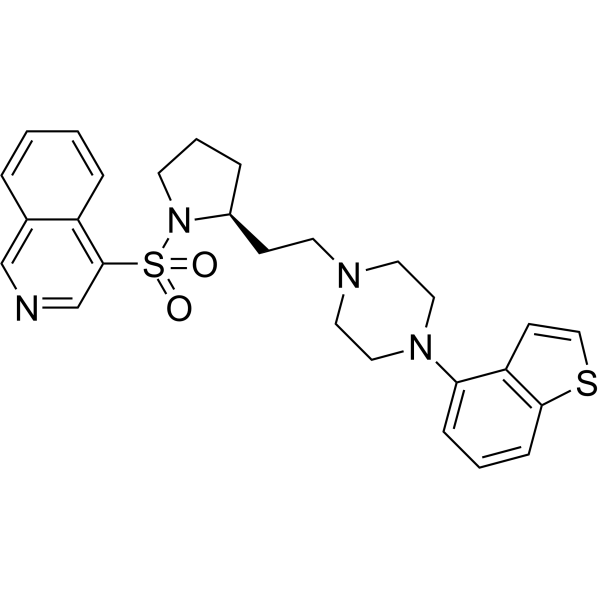
-
- HY-100665S
-
|
OPC-14857-d8; DM-14857-d8
|
Isotope-Labeled Compounds
5-HT Receptor
|
Neurological Disease
|
|
Dehydroaripiprazole-d8 is deuterium labeled Dehydroaripiprazole. Dehydroaripiprazole (OPC-14857) is an active metabolite of Aripiprazole. Aripiprazole is an antipsychotic agent and is metabolized by CYP3A4 and CYP2D6 forming mainly Dehydroaripiprazole. Dehydroaripiprazole has with antipsychotic activity equivalent to Aripiprazole[1][2][3].
|
-
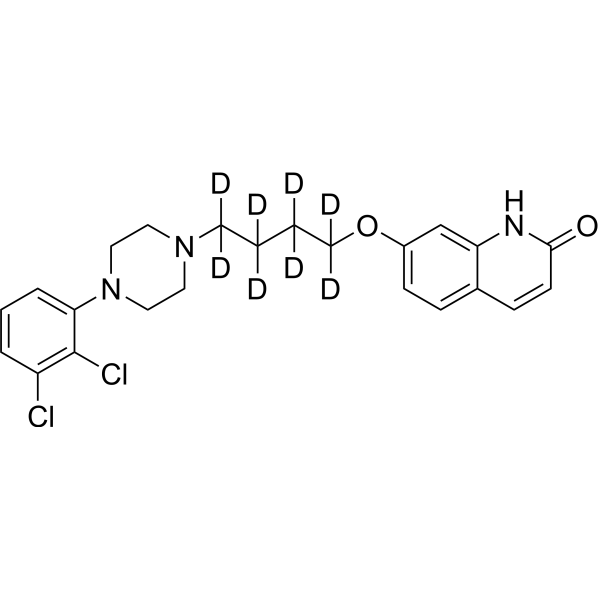
-
- HY-14562
-
|
|
mAChR
|
Neurological Disease
|
|
TBPB is an allosteric M1 mAChR agonist(EC50=289 nM) that regulates amyloid processing and produces antipsychotic-like activity in rats.
|
-
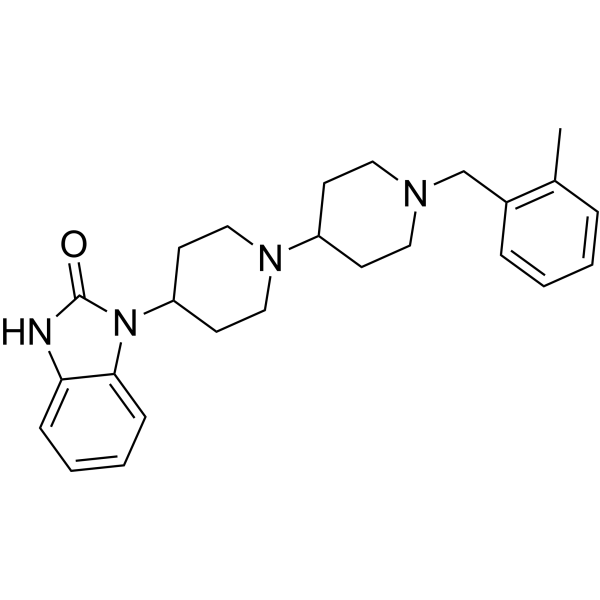
-
- HY-112432
-
|
|
GlyT
|
Neurological Disease
|
|
GlyT1 Inhibitor 1 is a potent and selective GlyT1 inhibitor with an IC50 of 38 nM for rGlyT1 . Antipsychotic activity .
|
-

-
- HY-100665R
-
|
OPC-14857 (Standard); DM-14857 (Standard)
|
5-HT Receptor
|
Neurological Disease
|
|
Dehydroaripiprazole (Standard) is the analytical standard of Dehydroaripiprazole. This product is intended for research and analytical applications. Dehydroaripiprazole (OPC-14857) is an active metabolite of Aripiprazole. Aripiprazole is an antipsychotic agent and is metabolized by CYP3A4 and CYP2D6 forming mainly Dehydroaripiprazole. Dehydroaripiprazole has with antipsychotic activity equivalent to Aripiprazole .
|
-
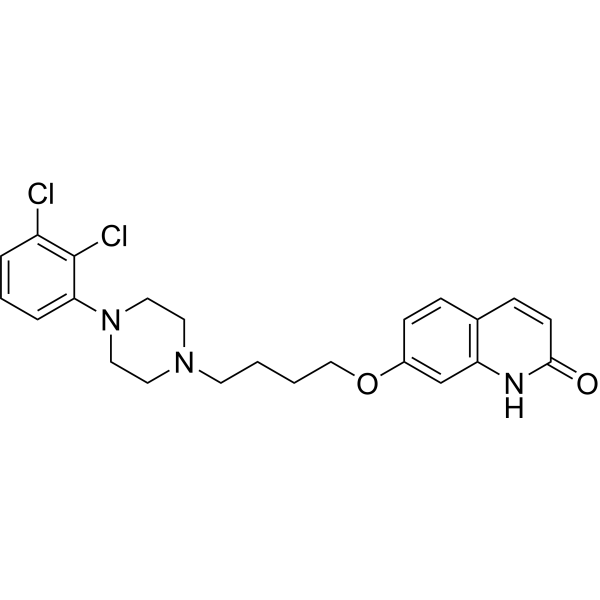
-
- HY-102062
-
|
N-omega-Propyl-L-arginine
|
NO Synthase
|
Neurological Disease
|
|
Nω-Propyl-L-arginine (N-omega-Propyl-L-arginine) is a potent, competitive, and highly selective inhibitor of neuronal nitric oxide synthase (nNOS), with a Ki of 57 nM. Nω-Propyl-L-arginine displays a 149-fold selectivity for nNOS over endothelial NOS (eNOS) .
|
-
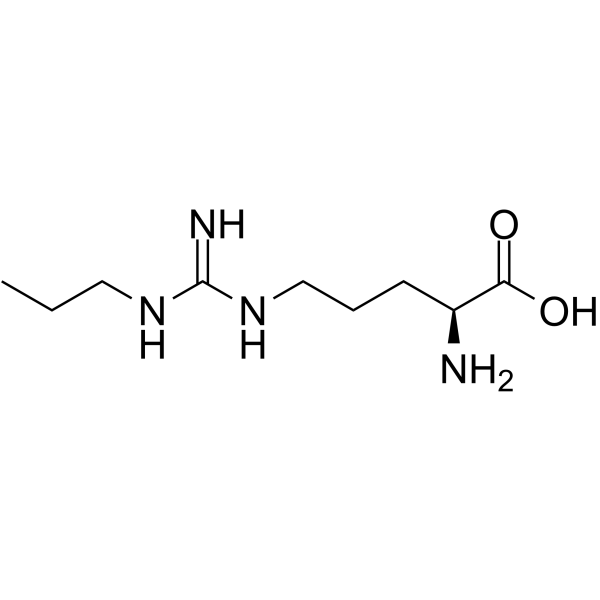
-
- HY-102062A
-
|
N-omega-Propyl-L-arginine hydrochloride
|
NO Synthase
|
Neurological Disease
|
|
Nω-Propyl-L-arginine (N-omega-Propyl-L-arginine) hydrochloride is a potent, competitive, and highly selective inhibitor of neuronal nitric oxide synthase (nNOS), with a Ki of 57 nM. Nω-Propyl-L-arginine hydrochloride displays a 149-fold selectivity for nNOS over endothelial NOS (eNOS) .
|
-

-
- HY-15793
-
|
(+)-DTBZ; (+)-α-Dihydrotetrabenazine; (+)-α-DHTBZ
|
Monoamine Transporter
|
Neurological Disease
|
|
NBI-98782 is a high affinity and selectivity vesicular monoamine transporter 2 (VMAT2) inhibitor with a Ki of 3 nM. NBI-98782 has antipsychotic activity .
|
-
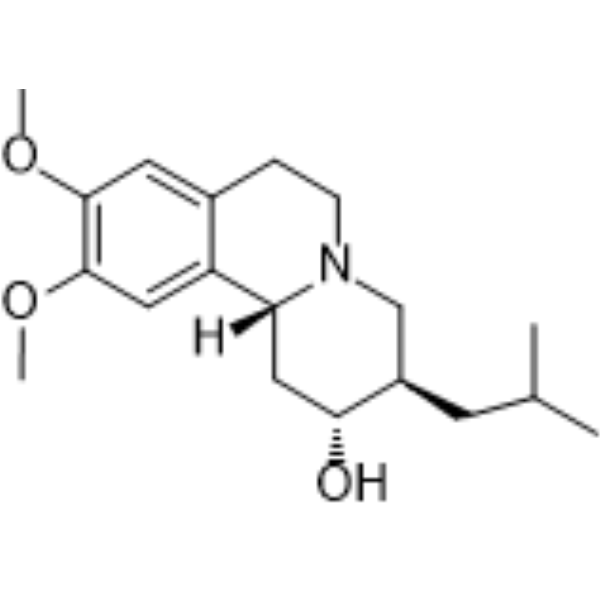
-
- HY-16996A
-
|
|
Sigma Receptor
|
Neurological Disease
|
|
BD-1047 (dihydrobromide) is a selective functional antagonist of sigma-1 receptor, shows antipsychotic activity in animal models predictive of efficacy in schizophrenia .
|
-
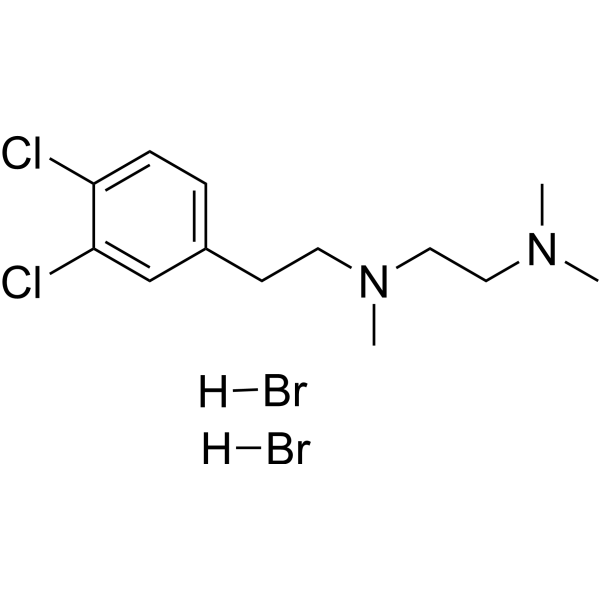
-
- HY-14542S
-
-
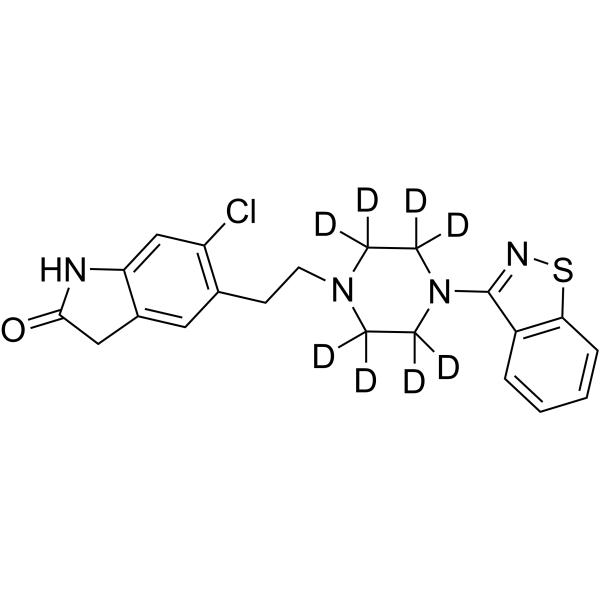
-
- HY-B0901
-
-

-
- HY-131255
-
|
Ziprasidone Impurity C; Ziprasidone open ring impurity
|
5-HT Receptor
Dopamine Receptor
|
Neurological Disease
|
|
Ziprasidone amino acid (Ziprasidone Impurity C) is an impurity of Ziprasidone. Ziprasidone is a combined 5-HT (serotonin) and dopamine receptor antagonist. Ziprasidone exhibits potent effects of antipsychotic activity .
|
-
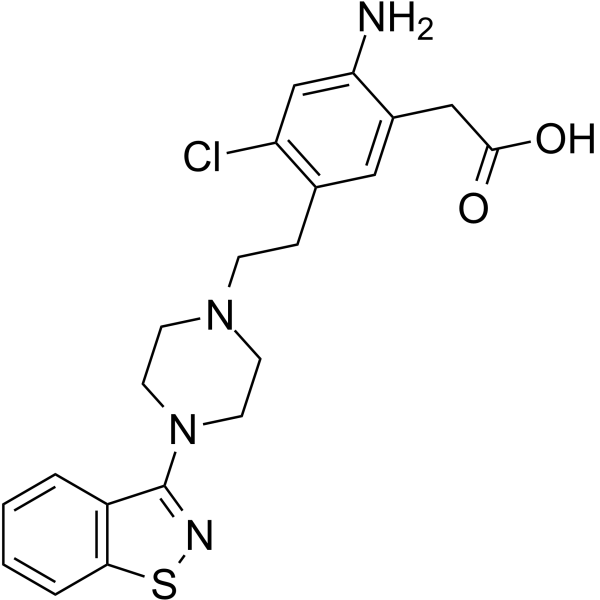
-
- HY-B0901A
-
|
R-11333 hydrochloride
|
Dopamine Receptor
Bacterial
|
Neurological Disease
|
|
Bromperidol (R-11333) hydrochloride possesses antipsychotic activity, with a high affinity for central dopamine receptors D2. Bromperidol hydrochloride can kill Mycobacteria in a synergistic manner with Spectinomycin .
|
-
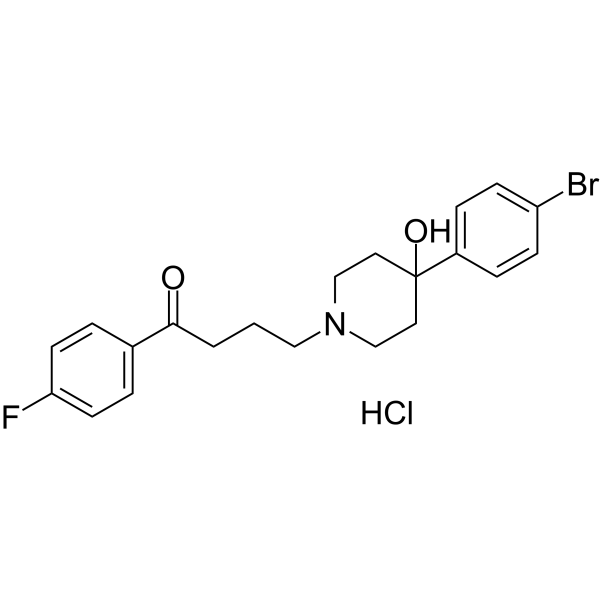
-
- HY-127120
-
|
|
Dopamine Receptor
|
Neurological Disease
|
|
Timiperone has a strong affinity for cerebral dopamine D2 receptor. Timiperone has antipsychotic activity, and inhibits stereotyped behaviour. Timiperone can be used for research of schizophrenia .
|
-
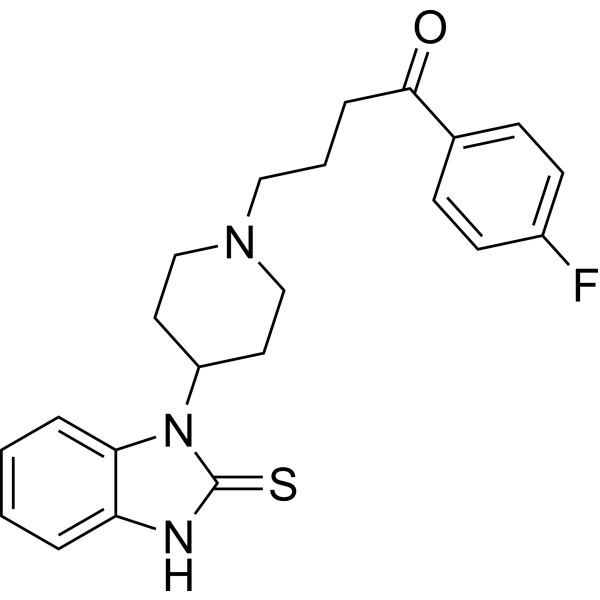
-
- HY-A0151
-
|
RP 7843; SKF 5883; Thioperazine
|
|
|
|
Thioproperazine (RP 7843) is an orally active antipsychotic agent with calming, antiemetic activity. Thioproperazine is effective in promoting the release of dopamine in rat striatum. Thioproperazine can be used in studies of schizophrenia and bipolar disorder .
|
-

-
- HY-B0274
-
-
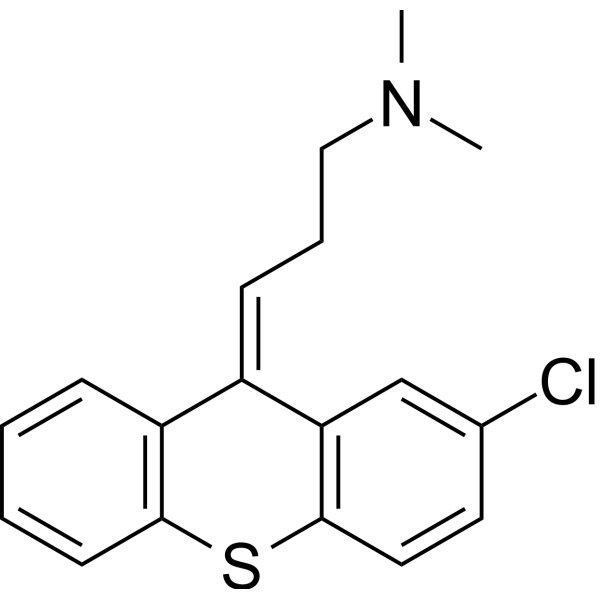
-
- HY-B0274A
-
-
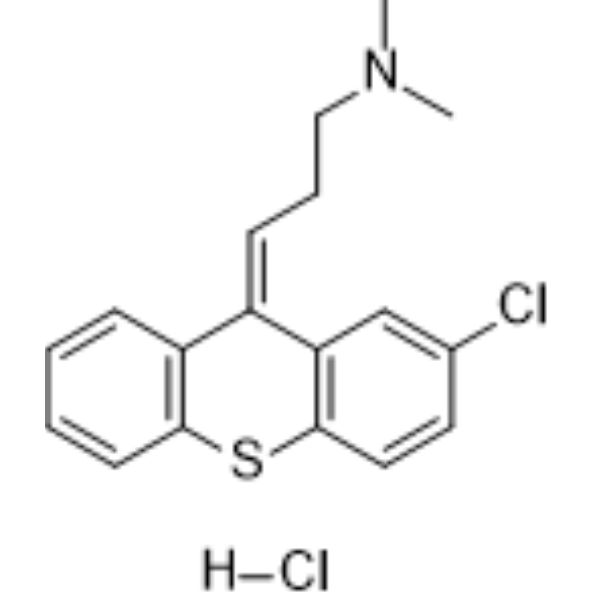
-
- HY-13058
-
|
|
mGluR
|
Neurological Disease
|
|
ADX-47273 is a potent, selective and brain-penetrant mGluR5 positive allosteric modulator (PAM), with an EC50 of 0.17 μM for potentiation of glutamate (50 nM) response. ADX-47273 has antipsychotic and procognitive activities .
|
-
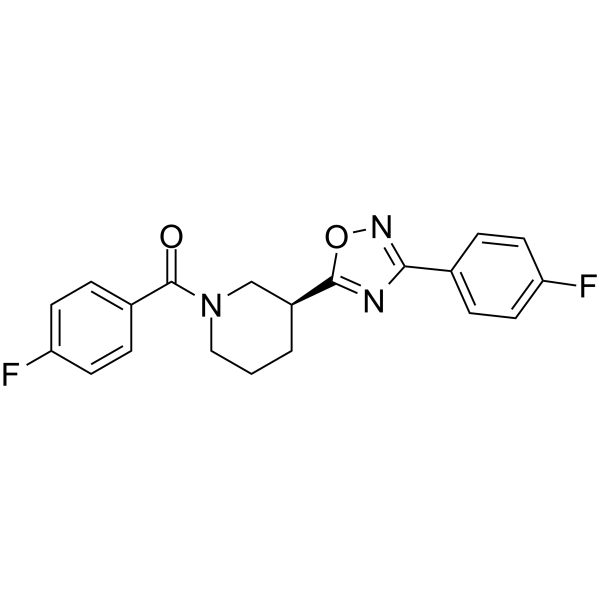
-
- HY-122015
-
|
|
Potassium Channel
|
Neurological Disease
|
|
ASP2905 is a potent and selective potassium channel Kv12.2 inhibitor encoded by the Kcnh3/BEC1 gene. ASP2905 can cross the blood-brain barrier and has antipsychotic activities .
|
-
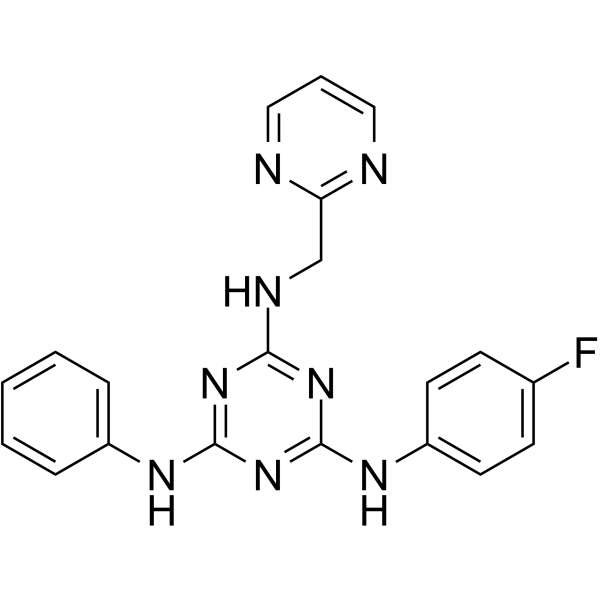
-
- HY-B0274AS
-
|
|
Dopamine Receptor
Histamine Receptor
Bacterial
|
Neurological Disease
|
|
Chlorprothixene-d6 (hydrochloride) is the deuterium labeled Chlorprothixene hydrochloride. Chlorprothixene hydrochloride is a dopamine and histamine receptors antagonist with Kis of 18 nM, 2.96 nM, 4.56 nM, 9 nM and 3.75 nM for hD1, hD2, hD3, hD5 and hH1 receptors, respectively. Antipsychotic activity[1].
|
-
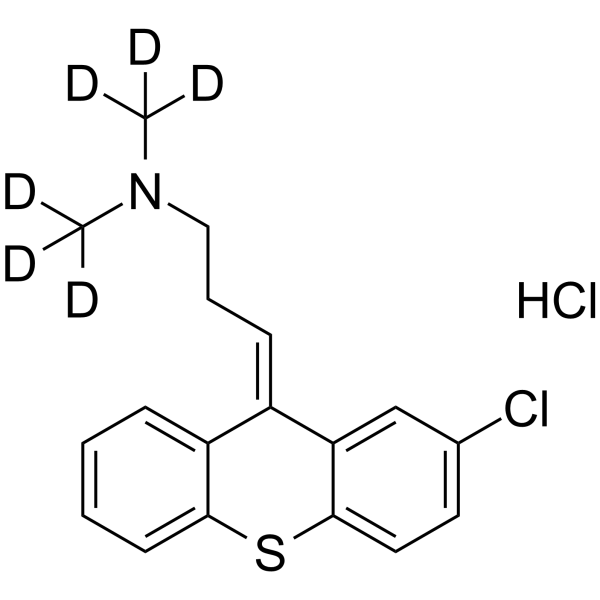
-
- HY-115447
-
|
|
Histamine Receptor
|
Neurological Disease
|
|
Clobenpropit is a potent histamine H3-receptor antagonist. Clobenpropit decreases dopamine release and increases histamine levels in the hypothalamus. Clobenpropit shows antipsychotic-like activities. Clobenpropit causes a resuscitating effect in rats subjected to the hemorrhagic shock .
|
-

-
- HY-105182A
-
|
LY 246708 tartrate
|
mAChR
|
Neurological Disease
|
|
Xanomeline (LY 246708) is the potent agonist of muscarinic M1/M4 receptor with antipsychotic-like activity. Xanomeline (LY 246708) increases neuronal excitability. Xanomeline (LY 246708) can be used for the research of schizophrenia .
|
-
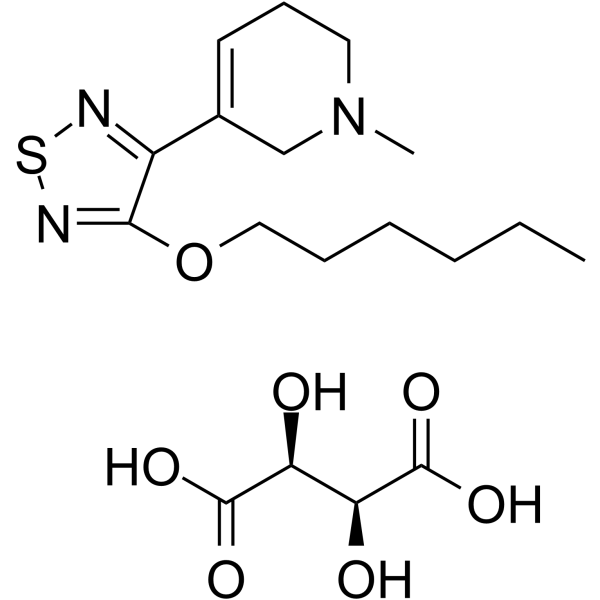
-
- HY-B0901R
-
|
R-11333 (Standard)
|
Dopamine Receptor
Bacterial
|
Infection
Neurological Disease
|
|
Bromperidol (Standard) is the analytical standard of Bromperidol. This product is intended for research and analytical applications. Bromperidol (R-11333) possesses antipsychotic activity, with a high affinity for central dopamine receptors D2. Bromperidol can kill Mycobacteria in a synergistic manner with Spectinomycin .
|
-
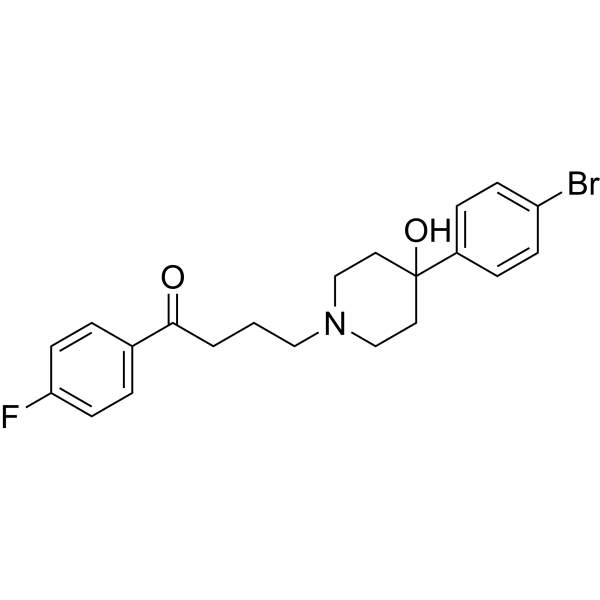
-
- HY-17390A
-
|
|
5-HT Receptor
Dopamine Receptor
|
Infection
Neurological Disease
|
|
Loxapine succinate is an orally active dopamine inhibitor, 5-HT receptor antagonist and also a dibenzoxazepine anti-psychotic agent. Loxapine can also suppresses bacterial efflux pump activity and inhibit intracellular multiple-antibiotic-resistant Salmonella enterica serovar Typhimurium in macrophages .
|
-
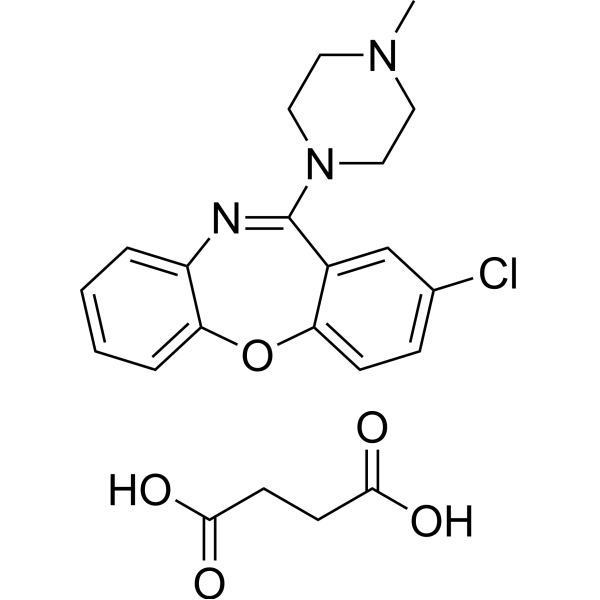
-
- HY-101484A
-
|
|
Sigma Receptor
|
Neurological Disease
|
|
NE-100 (hydrochloride) is a potent and selective sigma-1 receptor antagonist with an IC50 of 4.16 nM. NE-100 (hydrochloride) exerts antipsychotic activity in vivo[1]. NE-100 (hydrochloride) also suppresses ER stress-induced hippocampal cell death[2].
|
-
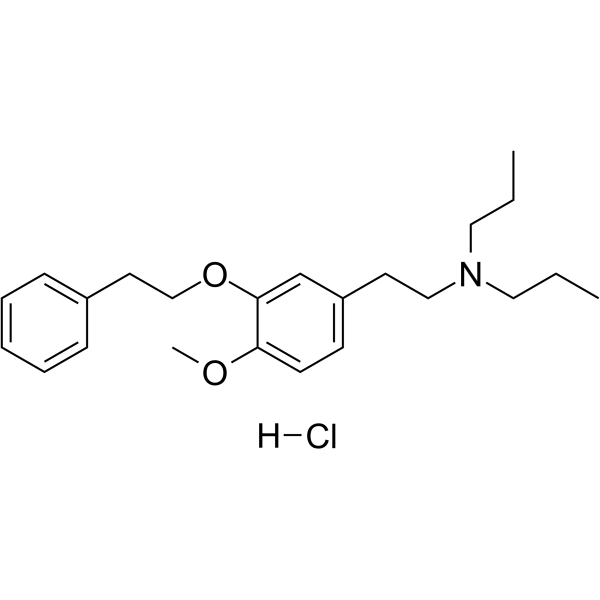
-
- HY-136281
-
|
|
Sigma Receptor
|
Neurological Disease
|
|
DuP 734 is a sigma receptor antagonist. DuP 734 is a selective and potent sigma and 5-HT2 receptor ligand with weak affinity for D2 receptors. DuP 734 may have antipsychotic activity without the liability of motor side effects typical of neuroleptics .
|
-
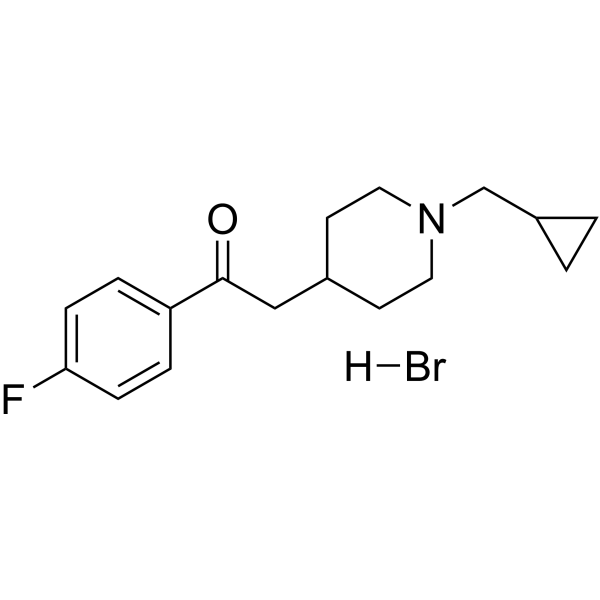
-
- HY-B0274R
-
|
|
Dopamine Receptor
Histamine Receptor
Bacterial
|
Neurological Disease
|
|
Chlorprothixene (Standard) is the analytical standard of Chlorprothixene. This product is intended for research and analytical applications. Chlorprothixene is a dopamine and histamine receptors antagonist with Kis of 18 nM, 2.96 nM, 4.56 nM, 9 nM and 3.75 nM for hD1, hD2, hD3, hD5 and hH1 receptors, respectively. Antipsychotic activity .
|
-
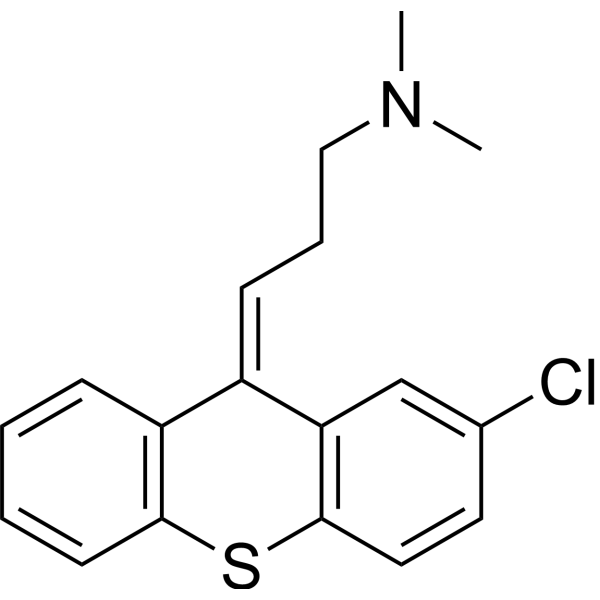
-
- HY-14264
-
|
|
5-HT Receptor
|
Neurological Disease
|
|
Cyamemazine is a neuroleptic agent that contains the phenothiazine chromophore. Cyamemazine is often used as an anxiolytic. Cyamemazine is a potent 5-HT3 (Ki of 12 nM), 5-HT2A (Ki = 1.5 nM) and 5-HT2C (Ki of 75 nM) receptors antagonist with antipsychotic activity .
|
-
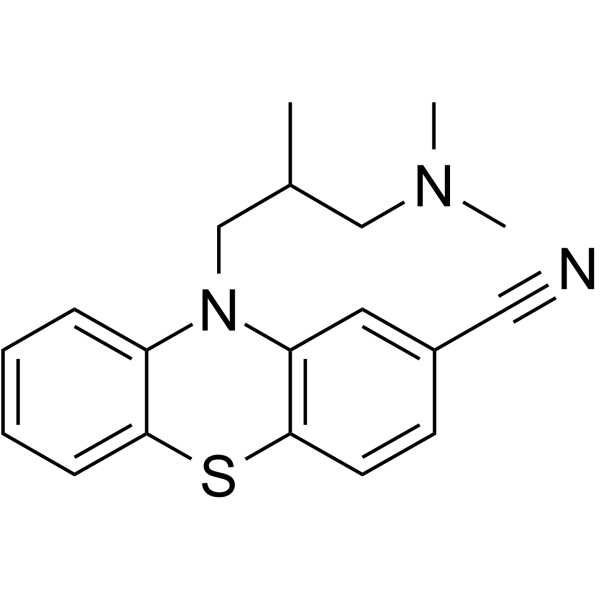
-
- HY-109157
-
|
RO6889450
|
Trace Amine-associated Receptor (TAAR)
5-HT Receptor
Dopamine Receptor
|
Neurological Disease
|
|
Ralmitaront (RO6889450) is an orally active agonist of trace amine-associated receptor 1 (TAAR1) with a EC50 value of 110.4 nM. Ralmitaront has antipsychotic, cognitively improvement, and antidepressant activity in rodents. Ralmitaront can be used as a neurosuppressant in the study of neuro-related diseases, such as schizophrenia (SCZ), schizoaffective disorder .
|
-
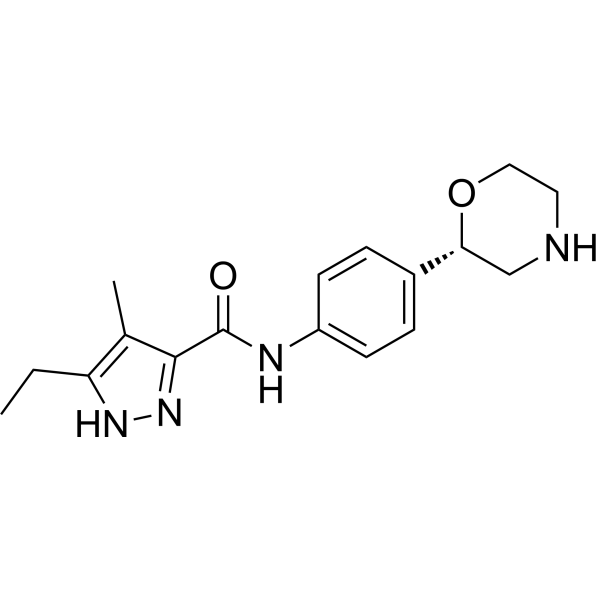
-
- HY-14264S
-
|
|
Isotope-Labeled Compounds
5-HT Receptor
|
Neurological Disease
|
|
Cyamemazine-d6 is the deuterium labeled Cyamemazine. Cyamemazine is a neuroleptic agent that contains the phenothiazine chromophore. Cyamemazine is often used as an anxiolytic. Cyamemazine is a potent 5-HT3 (Ki of 12 nM), 5-HT2A (Ki = 1.5 nM) and 5-HT2C (Ki of 75 nM) receptors antagonist with antipsychotic activity[1][2].
|
-
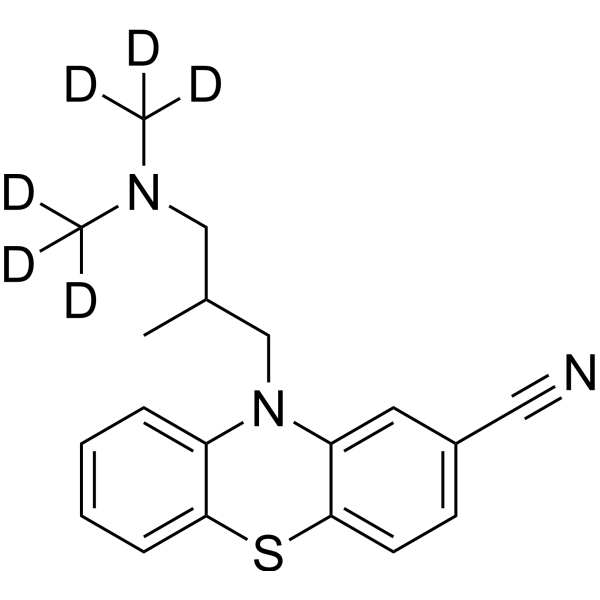
-
- HY-108512
-
|
|
Sigma Receptor
|
Neurological Disease
|
|
PD 144418 is a highly affinity, potent and selective sigma 1 (σ1) receptor ligand (Ki values of 0.08 nM and 1377 nM for σ1 and σ2 respectively). PD 144418 devoids of any significant affinity for other receptors, ion channels and enzymes. PD 144418 shows potential antipsychotic activity .
|
-
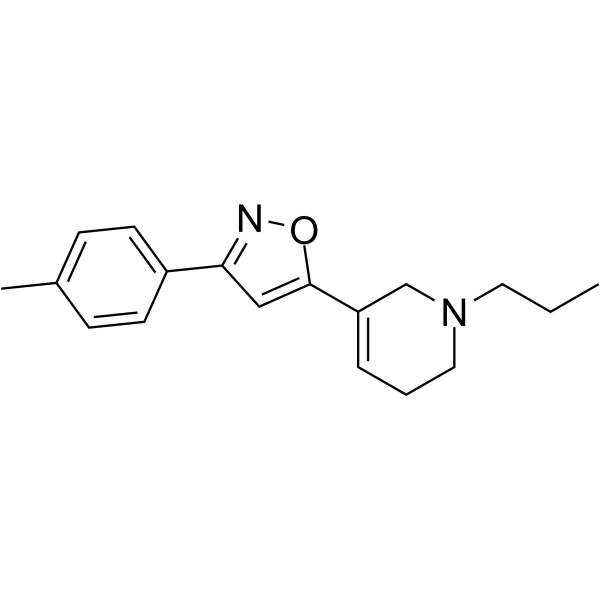
-
- HY-14940
-
Volinanserin
Maximum Cited Publications
6 Publications Verification
MDL100907; M 100907
|
5-HT Receptor
|
Neurological Disease
|
|
Volinanserin is a potent and selective antagonist of 5-HT2 receptor, with a Ki of 0.36 nM, and shows 300-fold selectivity for 5-HT2 receptor over 5-HT1c, alpha-1 and DA D2 receptors. Volinanserin has antipsychotic activity.
|
-
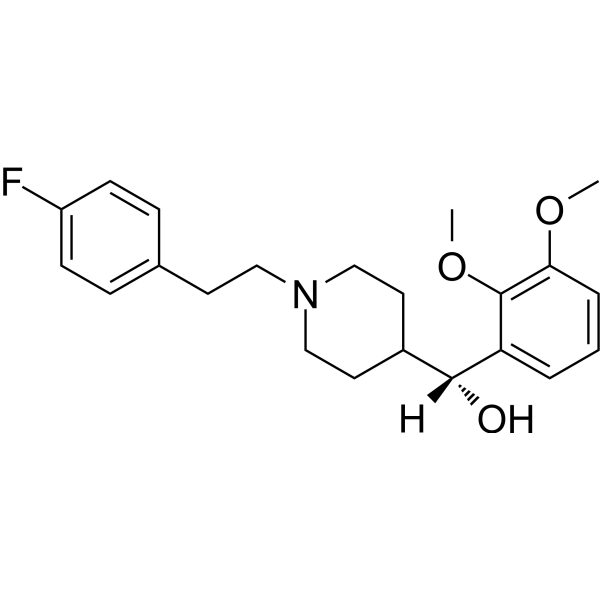
-
- HY-14940S
-
|
MDL100907-d4 hydrochloride; M 100907-d4 hydrochloride
|
5-HT Receptor
|
Neurological Disease
|
|
Volinanserin-d4 (hydrochloride) is the deuterium labeled Volinanserin hydrochlorid. Volinanserin is a potent and selective antagonist of 5-HT2 receptor, with a Ki of 0.36 nM, and shows 300-fold selectivity for 5-HT2 receptor over 5-HT1c, alpha-1 and DA D2 receptors. Volinanserin has antipsychotic activity[1][2].
|
-
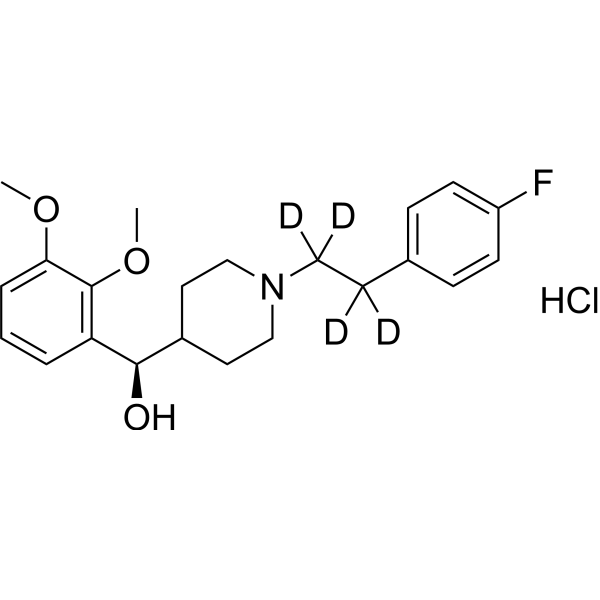
-
- HY-108512A
-
|
|
Sigma Receptor
|
Neurological Disease
|
|
PD 144418 oxalate is a highly affinity, potent and selective sigma 1 (σ1) receptor ligand (Ki values of 0.08 nM and 1377 nM for σ1 and σ2 respectively). PD 144418 oxalate devoids of any significant affinity for other receptors, ion channels and enzymes. PD 144418 oxalate shows potential antipsychotic activity .
|
-

-
- HY-106100
-
|
EMD 49980
|
Dopamine Receptor
Serotonin Transporter
|
Neurological Disease
|
|
Roxindole (EMD 49980), an indot-alkyl-pipenidine, is a potent agonist at dopamine autoreceptors, with an affinity for the D2-like subtype in the low nanomolar range. Roxindole can be used for the research of positive and negative schizophrenic symptoms. Roxindole is a 5-HT1A agonist and 5-HT uptake inhibitor. Antipsychotic and antidepressant activities .
|
-

-
- HY-117829
-
|
|
Dopamine Receptor
5-HT Receptor
Histamine Receptor
Arrestin
|
Neurological Disease
|
|
UNC9994, an analog of Aripiprazole, is a functionally selective β-arrestin-biased dopamine D2 receptor (D2R) agonist with EC50 <10 nM for β-arrestin-2 recruitment to D2 receptors. UNC9994 is simultaneously partial agonists of β-arrestin-2 translocation and antagonists of Gi-regulated cAMP production. Antipsychotic Activity .
|
-
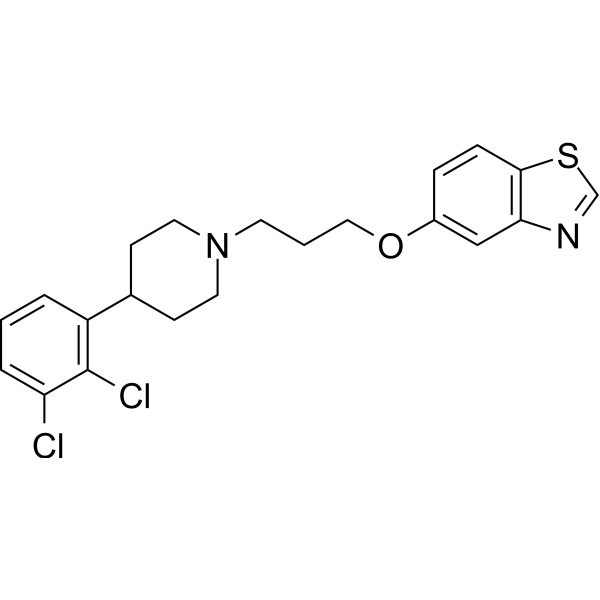
-
- HY-147395
-
|
|
GPR52
|
Neurological Disease
|
|
GPR52 agonist-1 is a potent, orally active and blood-brain barrier (BBB) penetrant GPR52 agonist with an pEC50 value of 7.53. GPR52 agonist-1 affects cAMP accumulation through direct interaction with GPR52. GPR52 agonist-1 can significantly suppress Methamphetamine-induced hyperactivity in mice. Antipsychotic activity .
|
-
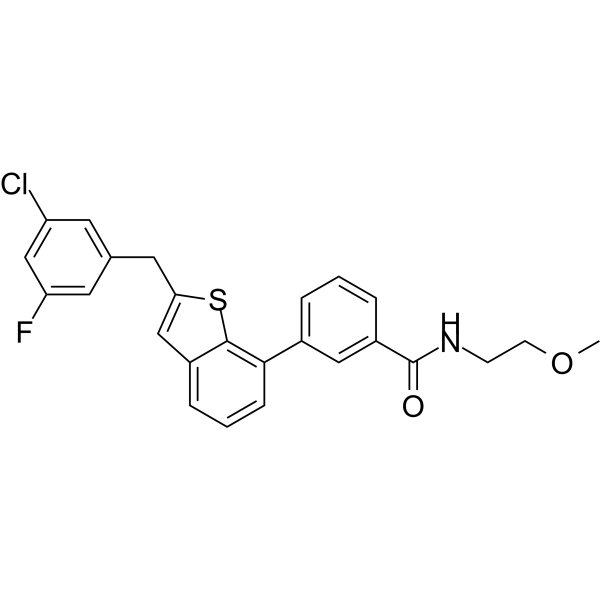
-
- HY-100971
-
|
AMI-193
|
|
|
|
Spiramide (AMI-193) is a potent and selective antagonist of 5-HT2 and dopamine D2 receptor, with Kis of 2 nM and 3 nM, respectively. Spiramide has >2000-fold selectivity for 5-HT2 versus 5-HT1C (Ki=4300 nM) receptors. Spiramide exhibits antipsychotic activity .
|
-
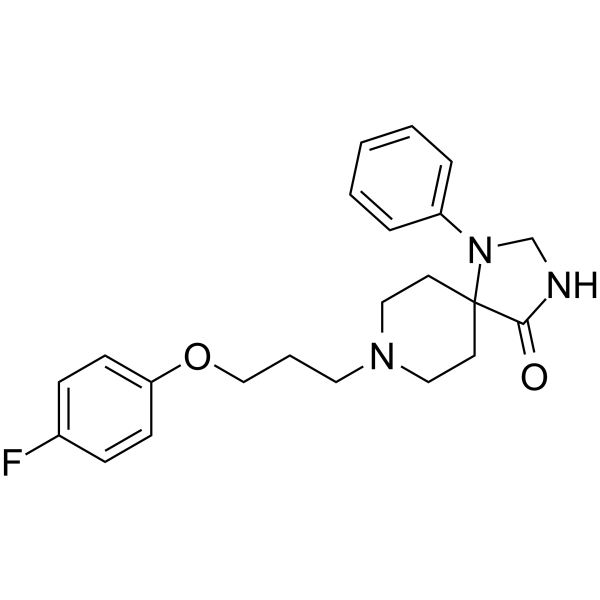
-
- HY-14940A
-
|
(S)-MDL100907; (S)-M 100907
|
5-HT Receptor
|
Neurological Disease
|
|
(S)-Volinanserin is an isform of Volinanserin (HY-14940). Volinanserin is a potent and selective antagonist of 5-HT2 receptor, with a Ki of 0.36 nM, and shows 300-fold selectivity for 5-HT2 receptor over 5-HT1c, alpha-1 and DA D2 receptors. Volinanserin has antipsychotic activity.
|
-
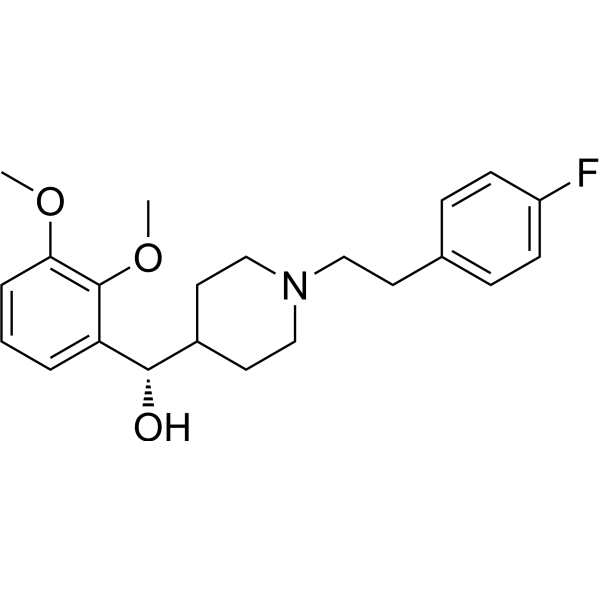
-
- HY-B0965A
-
|
|
|
|
|
Thioridazine, an antagonist of the dopamine receptor D2 family proteins, exhibits potent anti-psychotic and anti-anxiety activities. Thioridazine is also a potent inhibitor of PI3K-Akt-mTOR signaling pathways with anti-angiogenic effect. Thioridazine shows antiproliferative and apoptosis induction effects in various types of cancer cells, with specificity on targeting cancer stem cells (CSCs) .
|
-

-
- HY-156532
-
|
|
5-HT Receptor
|
Neurological Disease
|
|
5-HT2C agonist-3 ((+)-19) is a selective 5-HT2C agonist (EC50: 24 nM, Ki: 78 nM). 5-HT2C agonist-3 has antipsychotic drug-like activity. 5-HT2C agonist-3 blocks Amphetamine-induced hyperactivity .
|
-
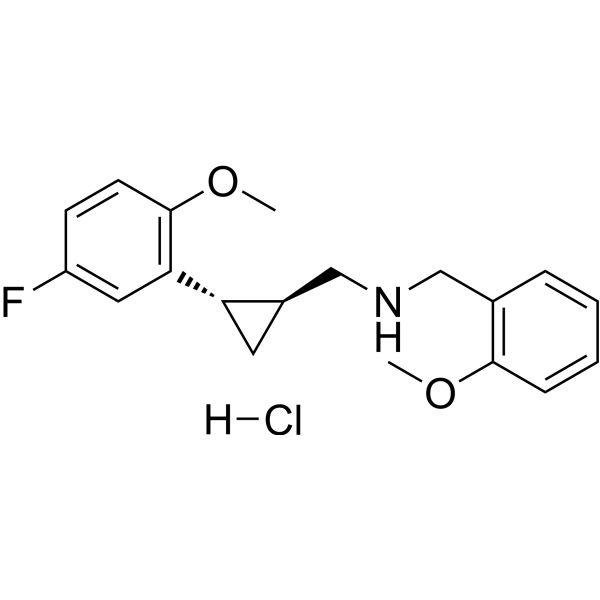
-
- HY-B0965
-
|
|
Dopamine Receptor
Apoptosis
5-HT Receptor
Autophagy
Bacterial
|
Infection
Neurological Disease
Cancer
|
|
Thioridazine hydrochloride, an orally active antagonist of the dopamine receptor D2 family proteins, exhibits potent anti-psychotic and anti-anxiety activities. Thioridazine hydrochloride is also a potent inhibitor of PI3K-Akt-mTOR signaling pathways with anti-angiogenic effect. Thioridazine hydrochloride shows antiproliferative and apoptosis induction effects in various types of cancer cells, with specificity on targeting cancer stem cells (CSCs) .
|
-

-
- HY-14327
-
|
|
Dopamine Receptor
|
Neurological Disease
|
|
FAUC 213 is an orally active and highly selective dopamine D4 receptor complete antagonist with a Ki of 2.2 nM for hD4.4. FAUC 213 has less activity on D2 and D3 receptors (Kis of 3.4 μM, 5.3 μM for hD2, hD3, respectively). FAUC 213 can cross the blood-brain barrier (BBB). FAUC 213 exhibits atypical antipsychotic characteristic .
|
-
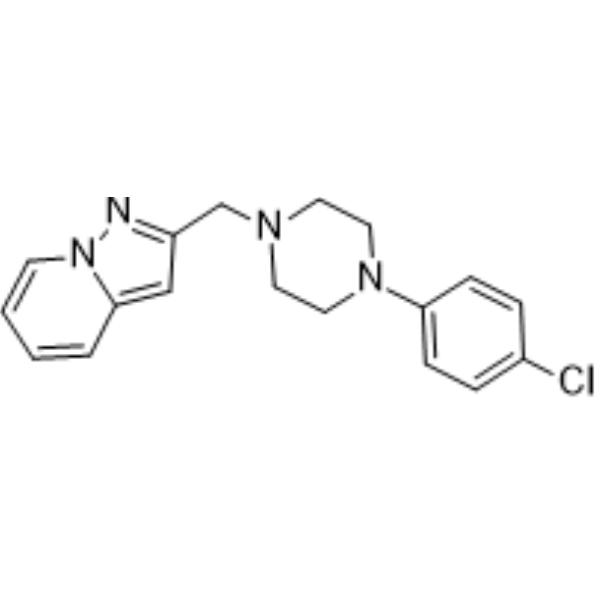
- HY-111385
-
|
|
Dopamine Receptor
5-HT Receptor
Arrestin
|
Neurological Disease
|
|
UNC9994 hydrochloride is a functionally selective, β-arrestin–biased dopamine D2 receptor (D2R) agonist that selectively activates β-arrestin recruitment and signaling. UNC9994 hydrochloride shows a binding affinity with a Ki of 79 nM for D2R. UNC9994 hydrochloride is also an antagonist of Gi-regulated cAMP production and partial agonist for D2R/β-arrestin-2 interactions. UNC9994 hydrochloride shows antipsychotic-like activity .
|
-
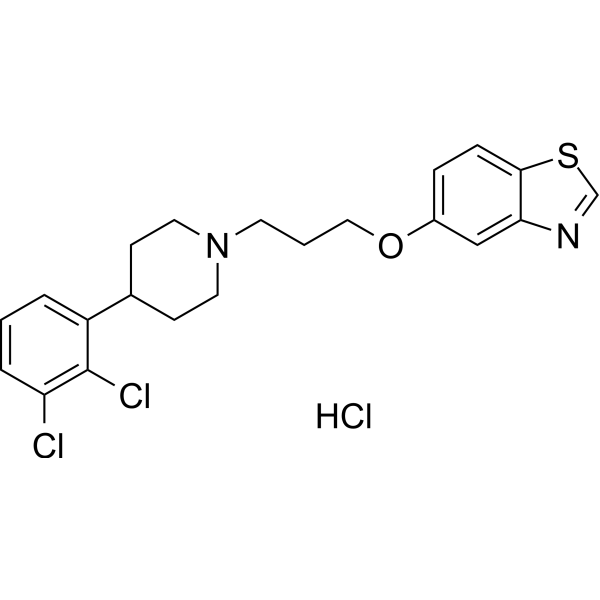
- HY-156532A
-
|
|
5-HT Receptor
|
Neurological Disease
|
|
5-HT2C agonist-3 ((+)-19) free base is a selective 5-HT2C agonist (EC50: 24 nM, Ki: 78 nM). 5-HT2C agonist-3 free base has antipsychotic drug-like activity. 5-HT2C agonist-3 free base blocks Amphetamine-induced hyperactivity .
|
-
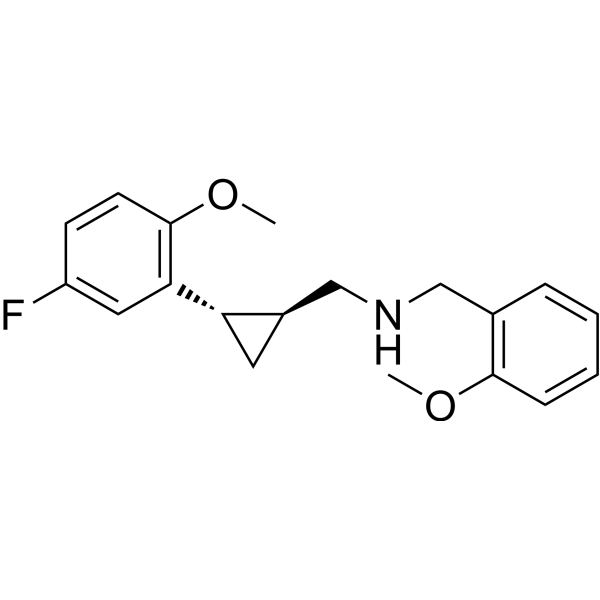
- HY-B0965AS
-
|
|
Dopamine Receptor
Apoptosis
5-HT Receptor
Autophagy
Bacterial
|
Neurological Disease
|
|
Thioridazine-d3 (hydrochloride) is the deuterium labeled Thioridazine. Thioridazine, an antagonist of the dopamine receptor D2 family proteins, exhibits potent anti-psychotic and anti-anxiety activities. Thioridazine is also a potent inhibitor of PI3K-Akt-mTOR signaling pathways with anti-angiogenic effect. Thioridazine shows antiproliferative and apoptosis induction effects in various types of cancer cells, with specificity on targeting cancer stem cells (CSCs)[1][2][3][4].
|
-

- HY-106100A
-
|
EMD 38362
|
Dopamine Receptor
Serotonin Transporter
|
Neurological Disease
|
|
Roxindole hydrochloride (EMD 38362), an indot-alkyl-pipenidine, is a potent agonist at dopamine autoreceptors, with an affinity for the D2-like subtype in the low nanomolar range. Roxindole can be used for the research of positive and negative schizophrenic symptoms. Roxindole is a 5-HT1A agonist and 5-HT uptake inhibitor with high affinity for 5-HT1A (IC50=0.9 nM). Antipsychotic and antidepressant activities .
|
-
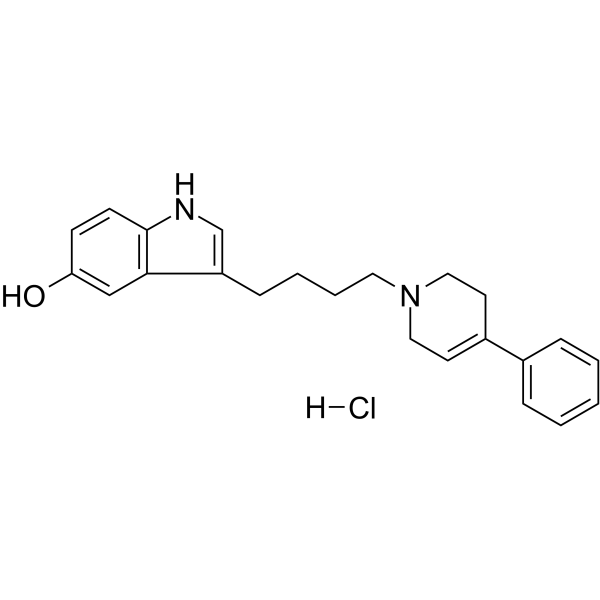
- HY-120184
-
|
AZ13713945
|
mAChR
|
Neurological Disease
|
|
VU0467485 (AZ13713945) is a potent, selective, and orally bioavailable muscarinic acetylcholine receptor 4 (M4) positive allosteric modulator (PAM). VU0467485 (AZ13713945) potentiates activity of ACh at M4 with EC50s of 26.6 nM and 78.8 nM at rat and human M4 receptors, respectively. VU0467485 (AZ13713945) shows selectivity for M4 over human and rat M1/2/3/5. VU0467485 (AZ13713945) displays moderate to high CNS penetration. VU0467485 (AZ13713945) has antipsychotic-like activity .
|
-

- HY-15780
-
|
OPC-34712
|
5-HT Receptor
Dopamine Receptor
Adrenergic Receptor
|
Neurological Disease
|
|
Brexpiprazole (OPC-34712), an atypical orally active antipsychotic agent, is a partial agonist of human 5-HT1A and dopamine D2L receptor with Kis of 0.12 nM and 0.3 nM, respectively. Brexpiprazole is also a 5-HT2A receptor antagonist with a Ki of 0.47 nM. Brexpiprazole also shows potent antagonist activity at human noradrenergic α1B (Ki=0.17 nM) and α2C receptors (Ki=0.59 nM) .
|
-
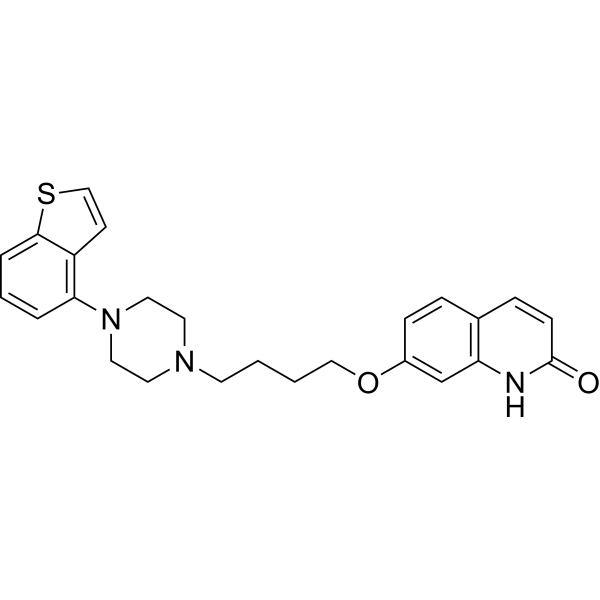
- HY-15780A
-
|
OPC-34712 hydrochloride
|
5-HT Receptor
Dopamine Receptor
Adrenergic Receptor
|
Neurological Disease
|
|
Brexpiprazole (OPC-34712) hydrochloride, an atypical orally active antipsychotic agent, is a partial agonist of human 5-HT1A and dopamine D2L receptor with Kis of 0.12 nM and 0.3 nM, respectively. Brexpiprazole hydrochloride is also a 5-HT2A receptor antagonist with a Ki of 0.47 nM. Brexpiprazole hydrochloride also shows potent antagonist activity at human noradrenergic α1B (Ki=0.17 nM) and α2C receptors (Ki=0.59 nM) .
|
-

- HY-B0965R
-
|
|
Dopamine Receptor
Apoptosis
5-HT Receptor
Autophagy
Bacterial
|
Infection
Neurological Disease
Cancer
|
|
Thioridazine (hydrochloride) (Standard) is the analytical standard of Thioridazine (hydrochloride). This product is intended for research and analytical applications. Thioridazine hydrochloride, an orally active antagonist of the dopamine receptor D2 family proteins, exhibits potent anti-psychotic and anti-anxiety activities. Thioridazine hydrochloride is also a potent inhibitor of PI3K-Akt-mTOR signaling pathways with anti-angiogenic effect. Thioridazine hydrochloride shows antiproliferative and apoptosis induction effects in various types of cancer cells, with specificity on targeting cancer stem cells (CSCs) .
|
-

- HY-B1371A
-
|
Spiroperidol hydrochloride
|
|
|
|
Spiperone hydrochloride (Spiroperidol hydrochloride) is a selective dopamine D2 receptor (Ki values of 0.06 nM, 0.6 nM, 0.08 nM, ~350 nM, ~3500 nM for D2, D3, D4, D1 and D5 receptors, respectively) and 5-HT2A/5-HT1A receptor (Kis of 1 nM/49 nM) antagonist. Spiperone hydrochloride is also a selective α1B-adrenoceptor antagonist. Spiperone hydrochloride activates calcium-activated chloride channel (CaCC). Antipsychotic and anti-inflammatory activities .
|
-
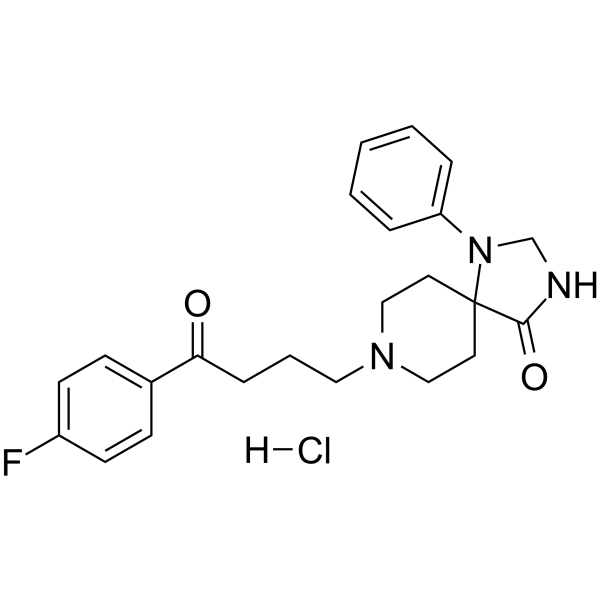
- HY-15780S1
-
|
OPC-34712-d8-1
|
Dopamine Receptor
Adrenergic Receptor
5-HT Receptor
|
Neurological Disease
|
|
Brexpiprazole-d8-1 is the deuterium labeled Brexpiprazole[1]. Brexpiprazole (OPC-34712), an atypical orally active antipsychotic agent, is a partial agonist of human 5-HT1A and dopamine D2L receptor with Kis of 0.12 nM and 0.3 nM, respectively. Brexpiprazole is also a 5-HT2A receptor antagonist with a Ki of 0.47 nM. Brexpiprazole also shows potent antagonist activity at human noradrenergic α1B (Ki=0.17 nM) and α2C receptors (Ki=0.59 nM)[2][3].
|
-
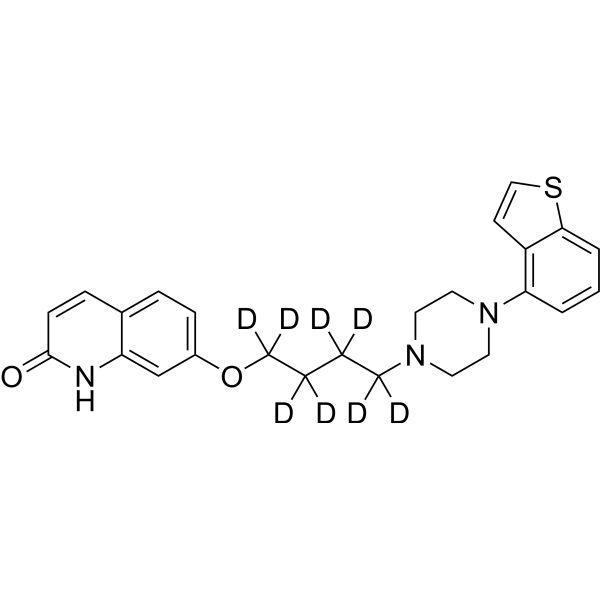
- HY-109112
-
|
RP5063
|
Dopamine Receptor
5-HT Receptor
|
Neurological Disease
Inflammation/Immunology
|
|
Brilaroxazine (RP5603) is a potent and orally active multimodal dopamine (DA)/serotonin (5-HT) modulator. Brilaroxazine is a partial agonist of dopamine (DA) D2, D3, and D4 receptors, 5-HT1A (Ki=1.5 nM) and 5-HT2A (Ki=2.5 nM), and has antagonist activity at 5-HT2B (Ki=0.19 nM), and 5-HT7 (Ki=2.7 nM) receptors . Brilaroxazine is an atypical antipsychotic agent, and has the potential to improve cognitive impairments in neuropsychiatric and neurological diseases in vivo .
|
-
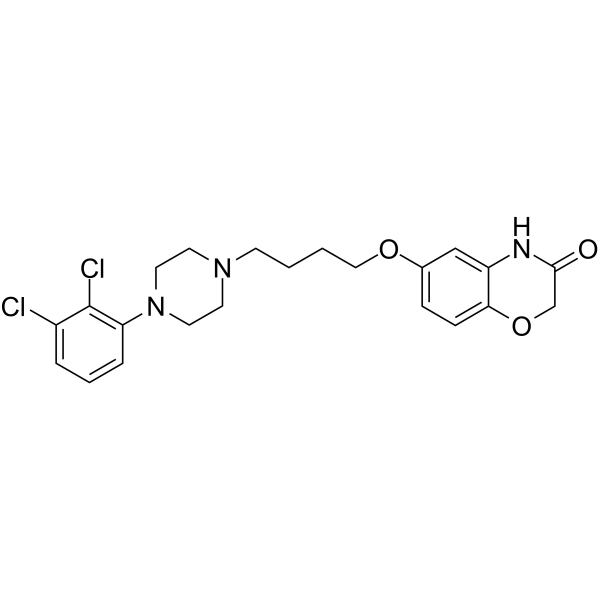
| Cat. No. |
Product Name |
Chemical Structure |
-
- HY-14542S
-
|
|
|
Ziprasidone-d88 is deuterium labeled Ziprasidone, which is a combined 5-HT (serotonin) and dopamine receptor antagonist which exhibits potent effects of antipsychotic activity.
|
-

-
- HY-14940S
-
|
|
|
Volinanserin-d4 (hydrochloride) is the deuterium labeled Volinanserin hydrochlorid. Volinanserin is a potent and selective antagonist of 5-HT2 receptor, with a Ki of 0.36 nM, and shows 300-fold selectivity for 5-HT2 receptor over 5-HT1c, alpha-1 and DA D2 receptors. Volinanserin has antipsychotic activity[1][2].
|
-

-
- HY-100665S
-
|
|
|
Dehydroaripiprazole-d8 is deuterium labeled Dehydroaripiprazole. Dehydroaripiprazole (OPC-14857) is an active metabolite of Aripiprazole. Aripiprazole is an antipsychotic agent and is metabolized by CYP3A4 and CYP2D6 forming mainly Dehydroaripiprazole. Dehydroaripiprazole has with antipsychotic activity equivalent to Aripiprazole[1][2][3].
|
-

-
- HY-B0274AS
-
|
|
|
Chlorprothixene-d6 (hydrochloride) is the deuterium labeled Chlorprothixene hydrochloride. Chlorprothixene hydrochloride is a dopamine and histamine receptors antagonist with Kis of 18 nM, 2.96 nM, 4.56 nM, 9 nM and 3.75 nM for hD1, hD2, hD3, hD5 and hH1 receptors, respectively. Antipsychotic activity[1].
|
-

-
- HY-14264S
-
|
|
|
Cyamemazine-d6 is the deuterium labeled Cyamemazine. Cyamemazine is a neuroleptic agent that contains the phenothiazine chromophore. Cyamemazine is often used as an anxiolytic. Cyamemazine is a potent 5-HT3 (Ki of 12 nM), 5-HT2A (Ki = 1.5 nM) and 5-HT2C (Ki of 75 nM) receptors antagonist with antipsychotic activity[1][2].
|
-

-
- HY-B0965AS
-
|
|
|
Thioridazine-d3 (hydrochloride) is the deuterium labeled Thioridazine. Thioridazine, an antagonist of the dopamine receptor D2 family proteins, exhibits potent anti-psychotic and anti-anxiety activities. Thioridazine is also a potent inhibitor of PI3K-Akt-mTOR signaling pathways with anti-angiogenic effect. Thioridazine shows antiproliferative and apoptosis induction effects in various types of cancer cells, with specificity on targeting cancer stem cells (CSCs)[1][2][3][4].
|
-

-
- HY-15780S1
-
|
|
|
Brexpiprazole-d8-1 is the deuterium labeled Brexpiprazole[1]. Brexpiprazole (OPC-34712), an atypical orally active antipsychotic agent, is a partial agonist of human 5-HT1A and dopamine D2L receptor with Kis of 0.12 nM and 0.3 nM, respectively. Brexpiprazole is also a 5-HT2A receptor antagonist with a Ki of 0.47 nM. Brexpiprazole also shows potent antagonist activity at human noradrenergic α1B (Ki=0.17 nM) and α2C receptors (Ki=0.59 nM)[2][3].
|
-

Your information is safe with us. * Required Fields.
Inquiry Information
- Product Name:
- Cat. No.:
- Quantity:
- MCE Japan Authorized Agent:





































































